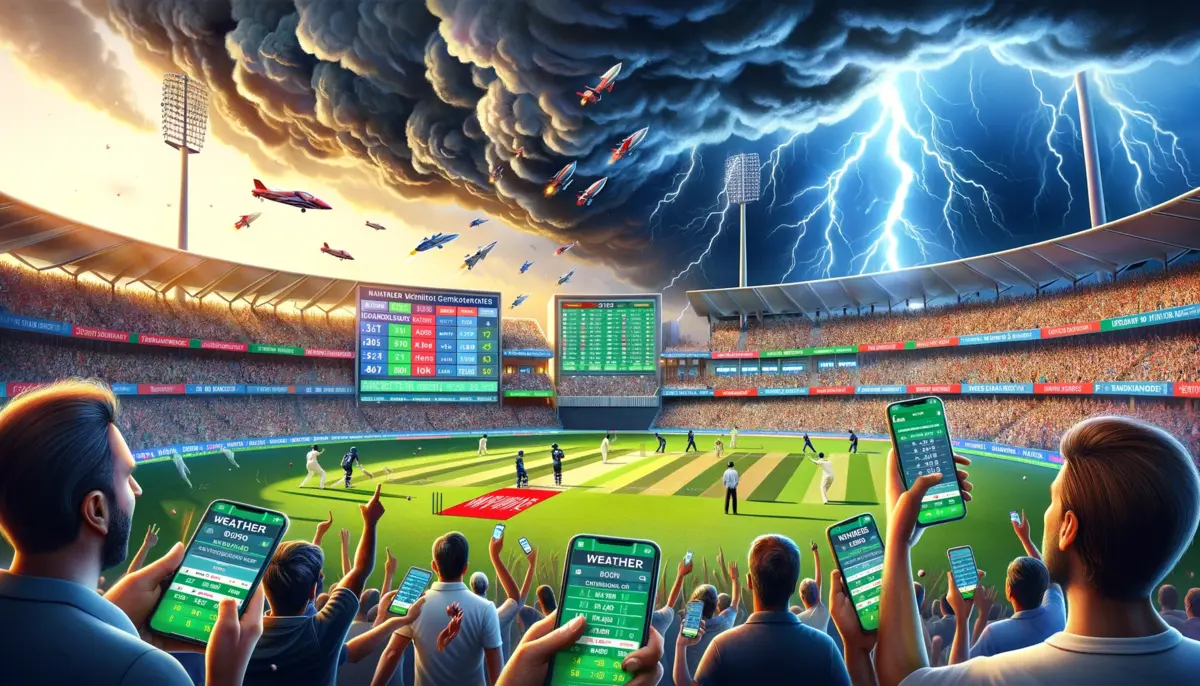Analyze the Impact of Weather on Cricket Betting Outcomes
Exploring the Impact of Weather on Cricket Betting Outcomes – While weather analysis can offer useful insights for cricket betting, results remain highly subject to the sport’s inherent uncertainties.
Historical data and forecasting may reveal helpful trends and patterns. However, no amount of research can reliably predict how weather dynamics will unfold in live matches.
Even with robust analysis, sheer chance and human performances under pressure play decisive roles. Maintaining perspective is key – excellent research should inform betting decisions but never override one’s own judgment.
Article Highlights
Hide- Extreme weather conditions such as heatwaves or rain delays can significantly impact player performance and increase the risk of injuries.
- Weather conditions like temperature, humidity, and wind can influence the behavior of the cricket ball, affecting the strategies of both batsmen and bowlers.
- Weather forecasts provide valuable insights for bettors, allowing them to make informed decisions and develop effective betting strategies.
- Foggy conditions can disrupt cricket matches, leading to delays, poor visibility, and challenges for both players and umpires.
In cricket’s unfolding drama, conditions change, and the best analytical models still fail to quantify unpredictable moments of brilliance or error.
By balancing weather insights with measured expectations, we can appreciate helpful data without surrendering to the false belief that consistent winning formulas exist in sports. The beauty of live cricket owes much to its unscripted surprises.
Historical Weather Patterns in Cricket

Analyzing historical weather patterns in cricket can provide valuable insights into the potential impact of weather on betting outcomes.
By examining historical weather data, we can gain a better understanding of how different weather conditions affect the game and, subsequently, the players’ performance.
One crucial aspect influenced by weather is player fitness. Extreme weather conditions, such as excessive heat or heavy rain, can significantly impact the physical and mental well-being of the players.
Mastering the Art of In-Play Cricket Betting Strategies
Mastering the Art of In-Play Cricket Betting Strategies – While in-play betting on cricket ... Read More
Hot and humid weather can cause players to become fatigued more quickly, affecting their ability to concentrate and make accurate decisions.
On the other hand, rainy conditions can make the field wet and slippery, leading to more frequent slips and falls, potentially causing injuries.
These factors can ultimately have an impact on the final outcome of a cricket match and, therefore, on the betting outcomes. Understanding the relationship between weather and player fitness is vital for bettors looking to make informed decisions.
By considering historical weather patterns and their impact on player performance, they can gain an edge in predicting the overall outcome of a match. However, weather alone is not the sole determining factor.
The subsequent section will explore the relationship between weather and pitch conditions, shedding light on the comprehensive analysis required for successful cricket betting.
The Relationship Between Weather and Pitch Conditions
The relationship between weather and pitch conditions is a crucial factor to consider when assessing the impact of weather on cricket betting outcomes.
Weather conditions such as temperature, humidity, and wind can significantly affect the behavior of the cricket ball, ultimately influencing the outcome of a match.
One important aspect to consider is the effect of weather on ball movement. Cooler temperatures tend to favor fast bowlers as the ball swings more, making it difficult for batsmen to play their shots effectively.
On the other hand, warmer temperatures reduce the swing and encourage spin, which benefits spin bowlers. Additionally, wind direction and speed can further impact the movement of the ball in the air.
Humidity also plays a significant role, particularly in relation to spin bowling. Higher humidity levels can cause the pitch to retain moisture, making it more favorable for spin bowlers as the ball grips the surface and turns sharply.
Conversely, lower humidity levels can result in drier pitches, which may aid fast bowlers with bounce and movement off the seam. To better understand the relationship between weather and pitch conditions, consider the following table:
| Weather Condition | Ball Movement | Pitch Conditions |
|---|---|---|
| High Temperature | Reduced swing | Favorable for spin bowling |
| Low Temperature | Increased swing | Beneficial for fast bowlers |
| High Humidity | Enhanced spin | Moist pitch |
| Low Humidity | Reduced spin | Dry pitch |
Understanding these relationships can help cricket bettors make more informed decisions by considering the potential impact of weather on pitch conditions and the subsequent advantage it may provide to certain types of bowlers.
Impact of Rain on Cricket Matches
When it comes to cricket matches, rain can have a significant impact on betting outcomes.
Rain interruptions can often lead to matches being abandoned or shortened, resulting in uncertainty and volatility in betting markets.
Additionally, the unpredictability of rain can affect the performance of players and the overall strategy of teams, further influencing the betting landscape.
Understanding the impact of rain on cricket matches is crucial for bettors looking to make informed decisions and capitalize on potential betting opportunities.
Rain’s Effect on Betting
During cricket matches, the presence of rain significantly influences the betting outcomes. The impact of rain delay and its effect on match dynamics can have a profound effect on the betting market.
When rain interrupts a match, it can lead to a change in the expected outcome and shift the odds in favor of the underdog or the team that is performing well at the time of interruption. To understand the extent of rain’s effect on betting, let’s take a look at the following table:
| Rain Delay (in hours) | Change in Odds | Betting Market Movement |
|---|---|---|
| 0-1 | Minimal | Negligible |
| 1-2 | Moderate | Slight |
| 2-3 | Significant | Noticeable |
| >3 | Substantial | Drastic |
As the duration of the rain delay increases, so does the impact on the odds and the overall betting market movement. This information is crucial for bettors to make informed decisions.
In the subsequent section, we will explore how match interruptions affect bets and delve deeper into strategies to mitigate potential losses.
Match Interruptions and Bets
Match interruptions due to rain have a significant impact on cricket betting outcomes. Weather-related betting strategies come into play when considering the potential impact of match delays caused by rain.
These interruptions can have a profound effect on the final result of a cricket match, making it crucial for bettors to adapt their strategies accordingly.
When a match is interrupted by rain, the dynamics of the game can change dramatically. The momentum built by one team can be disrupted, giving the opposing team an opportunity to regroup and potentially turn the tide in their favor. This unpredictability makes it challenging for bettors to accurately predict the outcome of a rain-affected match.
To navigate these uncertainties, bettors often utilize weather-related betting strategies. These strategies involve analyzing weather forecasts, pitch conditions, and player performance in rain-affected games to make informed betting decisions.
By incorporating these factors into their betting strategies, bettors can increase their chances of making successful wagers in rain-interrupted cricket matches.
How Wind Affects Batting and Bowling in Cricket
The wind significantly influences the performance of both batting and bowling in the game of cricket. Not only does it affect the fielding aspect of the game, but it also has a significant impact on spin bowling. Let’s take a closer look at how the wind affects these two crucial aspects of cricket.
When it comes to fielding, the wind can pose challenges for the players. Strong gusts can make it difficult for fielders to judge the trajectory of the ball, leading to misjudgments and dropped catches.
Additionally, the wind can also affect the accuracy of throws, making it harder for fielders to hit the stumps or deliver accurate throws to the wicket-keeper.
In terms of spin bowling, the wind can play a crucial role in determining the amount of turn a spinner can generate. Crosswinds can assist spinners in getting more drift, making it harder for the batsman to read the delivery. On the other hand, headwinds can negate the spin, making it easier for the batsman to counter the spin bowling.
Overall, the wind’s effect on fielding and spin bowling can be significant in cricket matches. Understanding and adapting to these conditions can give teams a competitive advantage. Moving on to the next weather condition, fog, let’s explore its impact on field visibility.
Fog and Its Impact on Field Visibility
In professional cricket matches, the presence of fog can significantly impact field visibility. This atmospheric condition can have various effects on the game, from match scheduling to fielding strategies. Here are four key ways in which fog can influence cricket matches:
- Match scheduling: Foggy conditions often lead to delays or disruptions in match schedules. The start of the game may be postponed until the fog clears, causing inconvenience for players, officials, and spectators. The uncertainty of when the fog will dissipate can create logistical challenges for organizing cricket matches.
- Fielding strategies: Poor visibility due to fog can make it difficult for fielders to track the ball. Fielders may struggle to judge the trajectory and speed of the ball, leading to potential misfielding or dropped catches. Additionally, fog can hinder communication between fielders, affecting teamwork and coordination on the field.
- Batting difficulties: Batsmen may find it challenging to sight the ball clearly in foggy conditions. Reduced visibility can make it harder to judge the line and length of the ball, affecting shot selection and timing. This can lead to lower batting scores and a higher rate of dismissals.
- Umpiring decisions: Foggy conditions can pose challenges for umpires in making accurate decisions. Reduced visibility may make it harder to determine if a catch has been taken cleanly or if the ball has hit the stumps. This can introduce an element of uncertainty and potentially impact the outcome of the game.
Considering the significant impact of fog on field visibility, cricket authorities and teams need to be prepared to handle such conditions effectively. Adequate measures and strategies should be in place to ensure fair play and the safety of players in foggy conditions.
The Role of Humidity in Cricket Matches
Fog’s impact on field visibility in professional cricket matches extends to the role of humidity as a key factor in determining playing conditions. Humidity plays a significant role in the movement of the cricket ball and the endurance of the players.
Humidity’s impact on ball movement is twofold. Firstly, high humidity levels increase the moisture content in the air, making the ball heavier.
This, in turn, affects the swing and movement of the ball through the air. The increased moisture in the air causes the ball to grip the air molecules, resulting in slower and more unpredictable movement.
On the other hand, low humidity levels reduce the moisture content in the air, making the ball lighter. This allows the ball to travel faster through the air, resulting in more consistent movement.
Humidity’s effect on player endurance is also worth considering. High humidity levels increase the body’s heat stress, making it harder for players to dissipate heat through sweating.
This can lead to fatigue and decreased performance. On the contrary, low humidity levels help in evaporative cooling, allowing players to regulate their body temperature more effectively, and thus enhancing their endurance.
Understanding the role of humidity in cricket matches is crucial for both players and bettors. It provides valuable insights into the potential movement of the ball and the endurance of the players, which can greatly influence the outcome of a match.
Now, let’s explore the impact of weather-related injuries and their influence on betting outcomes.
Weather-Related Injuries and Their Influence on Betting Outcomes
Weather-related injuries can have a significant impact on cricket betting outcomes. When players are injured due to weather conditions, it can affect their performance and ultimately influence the outcome of the match.
Player Injuries Impact Betting
Player injuries can significantly impact betting outcomes in cricket, especially when they are related to the weather. The availability of key players can greatly influence the performance and overall result of a cricket match.
When players are injured due to weather-related conditions, it can disrupt the balance of the team and affect their ability to perform at their best. This, in turn, can have a major impact on the betting outcomes.
To understand the influence of player injuries on cricket betting, it is important to consider the following factors:
- Team composition: Injuries to key players can lead to changes in the team composition, affecting the team’s overall strength and strategy.
- Performance impact: When a key player is injured, it can significantly impact the team’s performance, leading to unexpected outcomes in the match.
- Betting odds: Player injuries can cause fluctuations in the betting odds, as bookmakers adjust their predictions based on the availability of key players.
- Weather-related betting strategies: Weather conditions that contribute to player injuries can influence the strategies used by bettors, as they take into account the potential impact of weather on player performance and the overall outcome of the match.
Weather Affects Player Performance
The influence of weather on player performance and its impact on betting outcomes in cricket is a crucial aspect to consider.
Weather conditions such as rain delays and weather-related match cancellations can have a significant effect on player performance, ultimately influencing the outcome of a bet. Rain delays, for example, can disrupt a player’s rhythm and momentum, leading to a decline in performance.
Additionally, weather-related injuries can occur due to slippery grounds or adverse weather conditions, further affecting player performance.
These factors are important for bettors to consider when placing their bets, as they can significantly impact the final result. By analyzing historical data on weather conditions and player performance, bettors can make more informed decisions and increase their chances of success.
Understanding the relationship between weather and player performance is crucial for achieving positive betting outcomes in cricket.
The Effect of Heatwaves on Player Performance
Heatwaves significantly influence the performance of cricketers. The scorching temperatures and high humidity levels can have a profound impact on the stamina and hydration of players, leading to a decline in their overall performance. Here are four key ways in which heatwaves affect player performance:
- Reduced stamina: Heatwaves can cause players to feel fatigued and drained, resulting in a decrease in their endurance levels. The excessive heat puts a strain on the body, making it harder for players to maintain their stamina throughout the game.
- Dehydration: Heatwaves increase the risk of dehydration among cricketers. The combination of intense physical exertion and excessive sweating can lead to a loss of fluids and electrolytes, affecting the players’ concentration, focus, and physical abilities.
- Impaired cognitive function: The extreme heat can also impair the cognitive function of players. Heat stress can lead to mental fatigue, affecting decision-making, reaction time, and overall performance on the field.
- Increased risk of injuries: Heatwaves can increase the chances of injuries among cricketers. Dehydration and fatigue make players more susceptible to muscle cramps, heatstroke, and other heat-related ailments, which can significantly impact their ability to play at their best.
Understanding how heatwaves affect player performance is crucial for teams and bettors alike. Taking measures to mitigate the impact of heatwaves, such as proper hydration strategies and scheduling breaks during the hottest parts of the day, can help optimize player performance and enhance betting outcomes.
Weather Conditions and the Toss: Does It Matter
During cricket matches, weather conditions, including factors such as temperature, wind, and humidity, can potentially impact the outcome of the coin toss and subsequently influence the course of the game.
The toss plays a crucial role in cricket as it determines which team gets to bat or bowl first, giving them an advantage based on the prevailing weather conditions. To understand the impact of weather on the toss, let’s analyze the data from previous matches.
| Weather Condition | Toss Outcome |
|---|---|
| Sunny | Team A wins toss |
| Overcast | Team B wins toss |
| Rainy | Delayed toss |
| Windy | Team A wins toss |
From the table above, we can observe that different weather conditions have influenced the toss outcome. In sunny conditions, Team A has won the toss, indicating a potential preference for batting first.
On the other hand, in overcast conditions, Team B has won the toss, suggesting a preference for bowling first to take advantage of the potentially helpful conditions for bowlers.
Furthermore, rain delays can significantly impact match momentum. A delayed toss due to rain can disrupt the game’s rhythm and concentration of players, often leading to a slower start and possible changes in strategies.
In addition to the impact on gameplay, weather conditions also influence spectator attendance. People are more likely to attend matches on sunny days, while rainy or overcast conditions might deter some fans from attending, affecting the overall atmosphere of the game.
The Use of Weather Forecasts in Cricket Betting Strategies
Weather conditions play a significant role in cricket betting outcomes. The use of weather forecasts is crucial in formulating effective betting strategies.
Reliable weather prediction enables bettors to anticipate how weather conditions may impact the game. This allows them to make informed decisions on betting odds.
By considering factors such as rain, wind, and humidity, bettors can assess how these conditions may affect the performance of players and the overall outcome of the match.
Weather’s Betting Influence
The incorporation of meteorological predictions into cricket betting strategies significantly impacts the outcomes of wagers. Weather conditions have a profound effect on the mindset of players and can greatly influence crowd attendance. Here are four ways in which weather forecasts can influence cricket betting strategies:
- Player mindset: Weather conditions such as rain or extreme heat can affect the mindset of players, leading to changes in their performance. For example, rain can make the pitch wet and affect the ball’s movement, making it difficult for batsmen to score runs.
- Crowd attendance: Weather forecasts play a crucial role in determining crowd attendance at cricket matches. Unfavorable weather conditions can discourage spectators from attending matches, leading to a decrease in overall enthusiasm and energy.
- Pitch conditions: Weather forecasts provide valuable insights into the condition of the pitch. For instance, a dry pitch may favor spinners, while a wet pitch may favor seamers. This information can be used by bettors to make informed decisions.
- Match interruptions: Weather forecasts help predict the likelihood of match interruptions due to rain or bad light. These interruptions can have a significant impact on the outcome of a match, as they may result in reduced playing time or even match cancellations.
Reliable Weather Prediction
Accurate weather prediction plays a crucial role in informing cricket betting strategies and enabling bettors to make informed decisions.
To achieve reliable weather prediction, various weather models are utilized, incorporating advanced algorithms and data analysis techniques.
These models take into account multiple factors, such as temperature, humidity, wind speed, and precipitation, to forecast weather conditions accurately.
Weather data analysis is also crucial in identifying patterns and trends that can help bettors understand how weather affects the outcome of cricket matches.
By analyzing historical weather data and comparing it with the current forecast, bettors can make predictions on how weather conditions might impact the game. This information can then be used to adjust betting strategies accordingly.
Understanding the reliability of weather predictions is essential in making accurate assessments of how weather will impact odds in cricket betting.
Weather’s Impact on Odds?
Utilizing weather forecasts in cricket betting strategies has a significant impact on odds. Weather conditions can greatly influence the outcome of a cricket match, and bookmakers take this into account when setting the odds.
Here are four ways in which weather’s impact on betting odds can be observed:
- Rain delays: If rain is predicted during a match, bookmakers may adjust the odds to reflect the possibility of a shortened game or even a draw.
- Pitch conditions: Weather conditions such as moisture can affect the pitch, making it more favorable for either bowlers or batsmen. Bookmakers consider these factors when determining the odds for each team.
- Deteriorating light: Poor visibility due to bad light can lead to early stumps or even a game being abandoned. This uncertainty can affect the odds.
- Wind speed: Strong winds can impact the movement of the ball, favoring swing or spin bowlers. Bookmakers may adjust the odds to reflect these conditions.
Understanding weather’s influence on betting outcomes allows bettors to make more informed decisions and potentially gain an edge in their cricket betting strategies.
Do You Agree with the Impact of Weather on Cricket Betting Outcomes?
In conclusion, weather conditions have a significant impact on cricket betting outcomes.
Historical weather patterns, pitch conditions, rain, wind, fog, and heatwaves all play a role in influencing player performance and match results.
Weather-related injuries and field visibility also contribute to betting outcomes. Additionally, the toss can be influenced by weather conditions, affecting the outcome of the match.
Weather forecasts can be used as a valuable tool in developing cricket betting strategies. Overall, understanding the impact of weather on cricket is crucial for making informed betting decisions.








